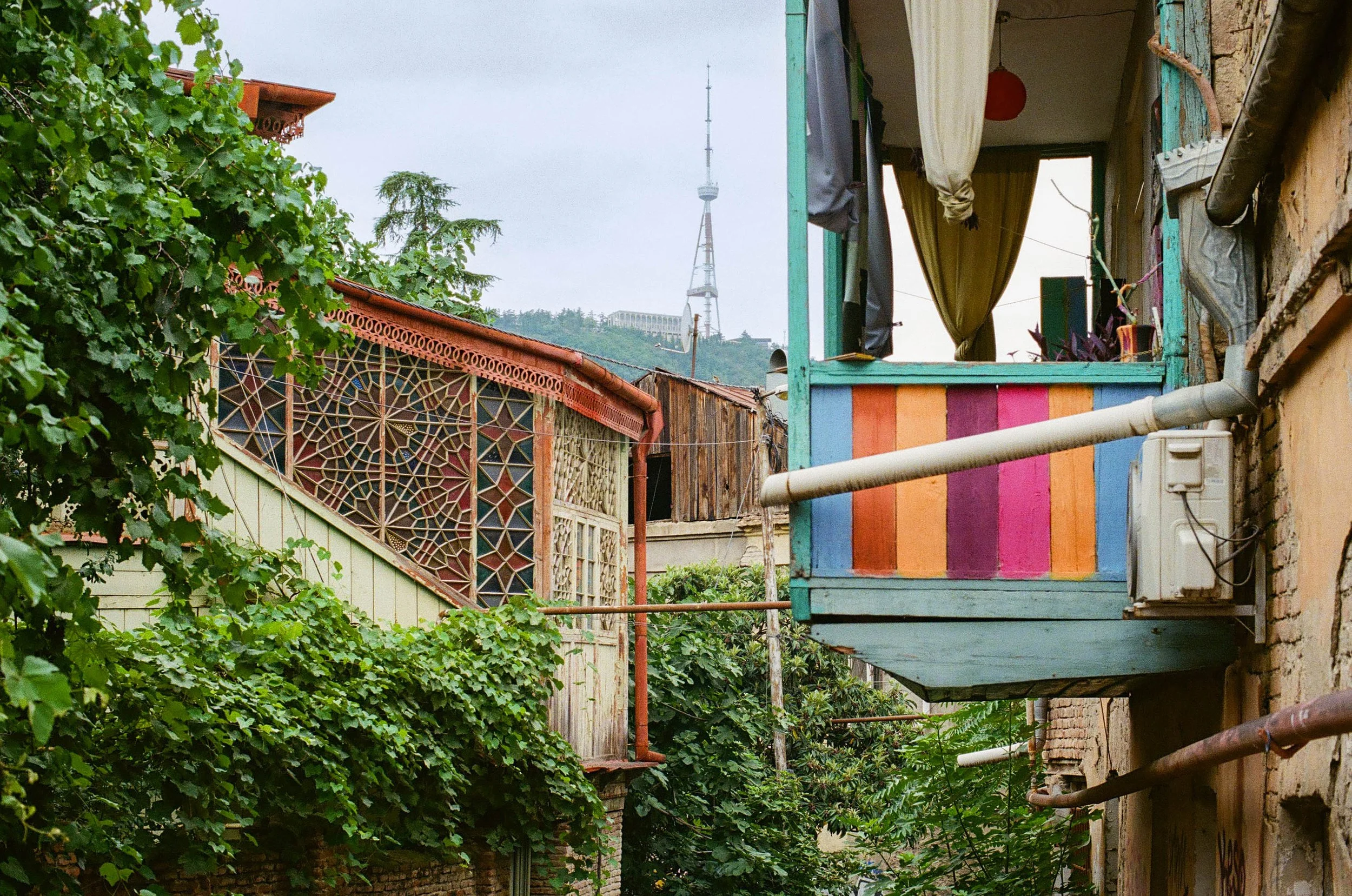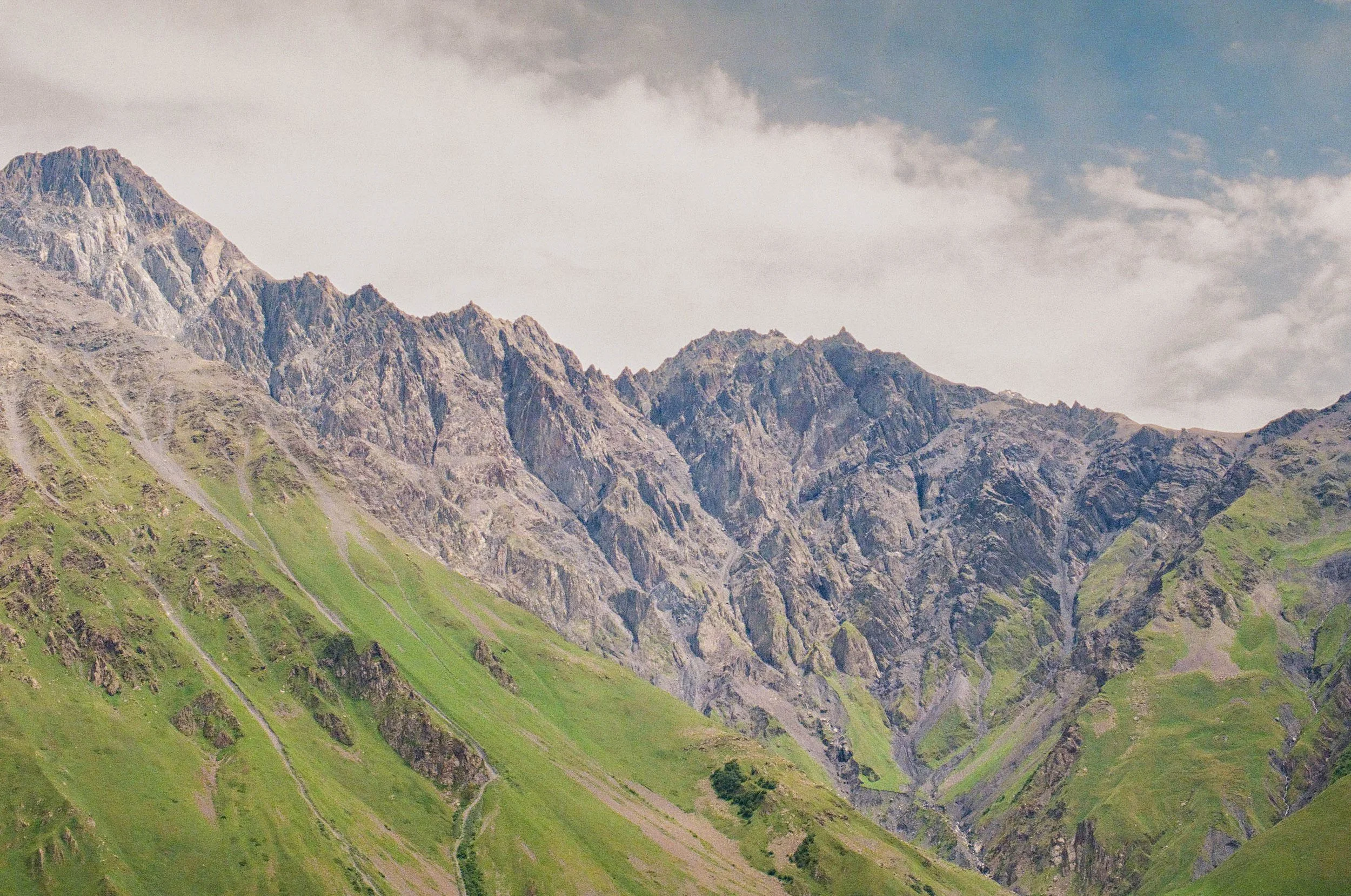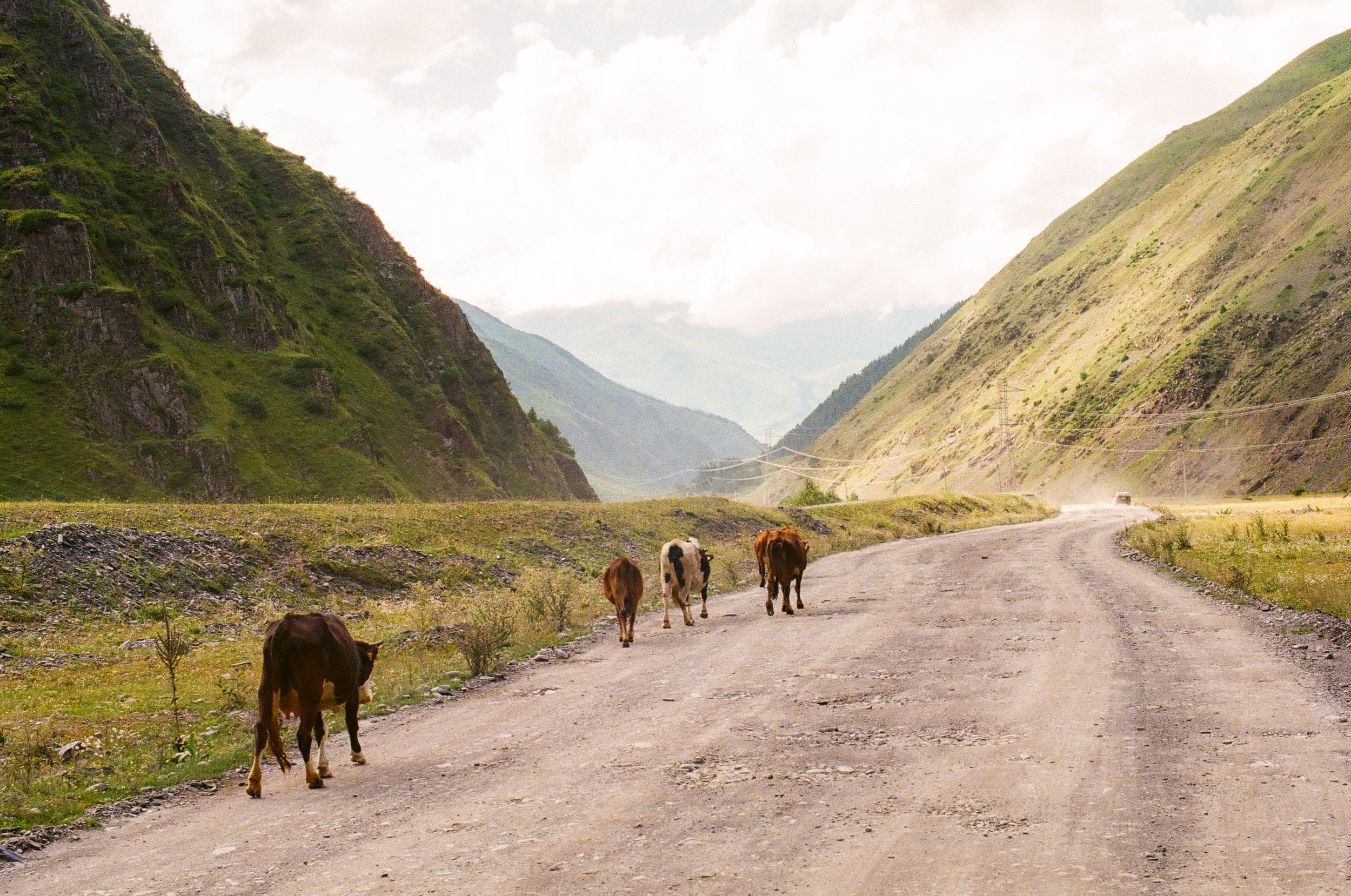Tbilisi, Georgia
Touch down in Tbilisi and dive headfirst into a captivating Georgian adventure with Paul and Louise as your guides. From the sulfurous steam of ancient baths to the vibrant pulse of the city’s hidden corners and the breathtaking landscapes beyond, their personal journey reveals the unexpected beauty and warm spirit of this fascinating land. Get ready to explore Tbilisi and its surroundings through their unique experience.
Paul - the arrival
“Welcome to Georgia”, says the taxi driver, going full throttle in his old Toyota on the empty streets of Tbilisi suburbs. He grabs a flask from the glove compartment. “Armenian cognac, the best in the world”. He laughs and nods at my French béret. It is 5AM and the sun slowly rises behind the caucasian mountains. The wind comes through the windows as the dusk starts to caress the old buildings, made of wood, metal, stone, cement and pastel colors. We feel dazed and confused after a long night flight and an endless queue at the Georgian customs in the middle of the night. As the birds start to sing in the small court of the hotel, probably from one of those big fig trees, we fall asleep both excited and exhausted.
A few hours later, we grab our bags, withdraw some laris in the ATM and try to find our way to the center of the city. Compared to the early hours of the day, the suburbs are hectic. We’ve read that honking in Georgia is rather common and not necessarily linked to anger, which we can rapidly confirm. On the bus, a young woman asks where we are from and recommends some places to hang out.
The bus drops us in Abanotubani, one of the oldest districts of Tbilisi, at the bottom of the mountains that surround the city. This neighborhood will be our base for the next few days, as we will wander peacefully in Tbilisi’s streets, alternating between warm rains and hot sunny days, either in crowded, chaotic streets and in more remote places surrounded by pomegranate, fig trees and laurel trees. But for now, after this short night, we crave for a proper sulfur bath, one of the “specialties” of Tbilisi.
Right in the heart of the capital, numerous shrubs and fruit trees (pomegranates, fig trees, vines, laurels...) line the alleyways and walking paths.
Café Dante, a large café on the third floor of a typical old town building, offering drinks, breakfasts, quick bites and more substantial meals amidst a lush terrace and a bohemian interior.
Café Linville, a stone’s throw from the vast Liberty Square, Café Linville seems to be a neighborhood institution. The typically Georgian cuisine offers honest and tasty dishes, and most tables and windows are adorned with freshly cut flowers. On the balcony, a canopy of vines shields from the summer sun.
Louise - the baths
It’s the smell of sulfur that hits first. An eggy scent, sharp and intrusive, clashing with the geometric beauty of the thousands of mosaics that climb up the walls of the luxurious private bathhouse Chreli Abano, nestled in the bath district of Abanotubani. Alexandre Dumas himself once praised the virtues of these sulfur baths, so closely entwined with the history of Tbilisi. The legend has it that it was during a hunting trip that King Vakhtang Gorgasali, accompanied by his falcon, discovered the thermal waters. The city was founded there specifically because of these underground hot springs, a fact still echoed in its name, Tbilisi, meaning “warm place.”
For around a hundred euros, we get the luxury of laying our bare bodies beneath the heat of the immense bluish dome, pierced by a single shaft of light. At the foot of Narikala fortress, along the banks of the Mtkvari River, we tune in to the slow release of tension in our muscles as we soak in the scalding water, fed directly by natural hot springs. Then, we plunge into cold water to catch our breath and spark our blood circulation. We repeat this cycle until we're completely spent. The experience is beautiful, but touristy, far from the public bathhouses that still resist postcard clichés.
Vulvas being shaved. That’s the first thing I see as I step into the baths at Public Bathhouse No. 5, a popular spot just a few brick domes away from Chreli Abano, where wisps of sulfur steam sometimes drift up into the air. A short, obese woman — no taller than a meter thirty. Her friend, skinny and clearly past eighty, chatting casually while brushing her teeth. Regulars, coming here each week to enjoy a women-only space to care for their bodies and their friendships. All the women are naked, except me, the fool in a bikini bottom, clutching my chest with both hands. And I realize : among all those who shave their pubic hair, it’s the one wearing a swimsuit that gets the most attention. The woman at the locker room desk asks me where I’m from. She hums Joe Dassin and sings. L’Amérique, L’Amérique.
I mime a swimming stroke. So, when do I get to bathe? I quickly understand that I will not enjoy baths, which are reserved for men. Women only have access to the sulfur showers. She insists : I have to finish my tea (nearly a liter to drink alone, practically naked in the middle of the locker room) before heading back to the showers for my scrub. She yells at me in Georgian if I question the protocol. I keep quiet.
The scrubbing mitt drills into my skin. An unforgettable experience for me, just another shift for the masseuse. The massage itself is a workout. Stand up, turn around, lie down, spread your legs, lean forward, slap on the back to flip me over. Intimacy is an abstract concept I quickly shed in this steamy room. To rinse me off, a bucket of cold water, thrown unceremoniously in my face. Outside, I meet up with Paul. He’s smiling, relaxed. “You didn’t get a bath?”
Behind a small open door in the middle of an out-of-the-way street, dozens of books are stored along a walkway. A passerby tells us that anyone can help themselves here, or leave a book of their choice.
Most buildings in the old town are built around central courtyards where the mix-and-match of wood, brick, and metal adds to the city’s charm.
Paul – the streets
Tbilisi is often depicted as a “bohemian-stye” city, as it was once a main hub of the silk road. Thus, it has integrated various influences in its architecture. Pastel colors, Italian courtyards, art nouveau’s features, wooden balconies, arabesques, blend up with monolithic neoclassical buildings in a very cinematographic ambiance, reminding for example the Tangier of Only lovers left alive.
As we discovered the city, we noticed that this beautiful blend was also present in the culture. Some locals described Georgian culture (and especially in Tbilisi) as a mix between Asian and European, but also as increasingly attractive for people from all over the world. Some places clearly illustrate this phenomenon, such as Fabrika or Mutant Radio, a local radio and concert hall featuring Georgian talents and international guests. Mutant Radio has also been a channel for political resistance, especially since the government’s decision to postpone the negotiation process to join the EU in November 2024. This measure has disappointed a huge part of the population, especially among the youth, which was looking for a stronger bond with the EU instead of Russia (many graffiti in Tbilisi’s streets expressed the anger against Russia and the support with Ukraine).
Louise – David Gareja
Tbilisi is home to over 35,000 stray animals. They've become part of the Georgian landscape now, like the overfilled lips of Russian tourists, the brick domes above the sulfur baths, and the khachapuri, the iconic cheese-filled bread shaped like a little boat, which we order at every meal. We always eat too much and struggle with the few hundred meters it takes to climb back to our room, 17 euros a night, perched at the top of the old town.
The kitchen is tucked into the stone walls and doubles as both a terrace and a sanctuary for a family of cats. Like most of our neighbors, we are now used to leave out small plates of scraps, cheese rinds, bits of meat, bowls of water. Three kittens have claimed the couch. Paul and I hunker down on two small wooden chairs, sipping beers and watching tourists float above the colorful rooftops of the old town in cable cars, heading toward the base of Kartlis Deda, the Mother of Georgia. Far below, dozens of dogs curl up on the stone steps, soaking in the shade and catching the occasional stroke from a child or passing tourist. According to Mikheil, our guide that we will talk about below, the city has in recent years launched a sterilization campaign and tries to chipp most of the stray dogs. They’re part of the landscape.
We are waiting for our guide on the edge of Tbilisi’s old town, in a lively, touristy corner of the capital. We’re heading to the David Gareja monastery, a semi-cave temple located in the desert region between the wine region of Kakheti and Azerbaijan, where parts of the buildings are carved directly into the rock. The monastic complex was founded by Monk David, one of the thirteen Assyrian monks who came to Georgia to spread Christianity in the 6th century. Legend has it that he lived in the caves at the summit.
But the story that really struck us right in the heart was that of Mikheil, our guide for the day. After his family died in a car accident when he was eight years old, he was raised by monks in a monastery. There, he learnt the history of Georgia, its theology, its borders and landscapes, before leaving the monastic life at 18 years old to discover the world and its people. Today, he is particularly attentive about respecting the codes of the sacred places and praying to the right saints. He seems less interested in politics : corruption, Russia growling at the borders and nibbling away a few centimeters of territory every day, the massive demonstrations of April 2023 in favor of joining the European Union, the thousands of anti-Russia tags that scratch Tbilisi’s walls? He’d rather not talk about it, but is more than willing to lead us right up to the Azerbaijani borders surrounding the complex, guarded by a few soldiers it’s best not to photograph. From up there, we admire the “rainbow mountains,” desert mountains striped with golden and reddish colors, shaped by sun, time and elements.
It’s time to head back, but not without a stop at a huge distillery where spitting out the generous half-dozen glasses offered by our guide is simply not an option, all to the rhythm of Ace of Base hits. On the way, we pass a few stray dogs lying down next to watermelon sellers’ stands. Snuggled up against each other, Paul and I sing in the backseat: "My love is my engine, and you might be fuel."
For an excursion of at least a day, the Kazbegi region is clearly a must-see. In the far north of the country, at the end of the old military road, the Caucasus mountains create a landscape where free-roaming cows and horses meet sharp ridges and mountain chapels.
Paul – Kazbegi
After a few days in Tbilisi and the excursion to David Gareja, we decide to leave the city and head for the mountains, especially the Kazbegi region, up in the North, right next to the Russian border. The road (an old military line) goes through the old town of Mtskheta, which used to be the capital of Georgia. We crossed small villages and fields, surrounded by small shops on the roadside, small shacks selling huge watermelons, souvenirs and candies.
Driving in Georgia can be a challenging experience : a two-lined road can easily become a three or four-lined one, as people tend to cross in various directions and park in front of the shops without necessarily warning. Some roads, like the one that goes to Kazbegi, are also quite old and damaged. But even though it was a bit stressful at first, we easily went with the flow. However, even though the trip to Kazbegi was supposed to last for about three hours, we needed two more hours as the traffic was slowed down in the middle of the mountains.
Once in the valley of Kazbegi, we started our trip by visiting the areas close to Stepantsminda, the main town. But the region is so beautiful and sceneric that a regular drive could basically lead us to breathtaking places filled with sheeps, cows (often on the middle of the road) and wild horses.
We visited the very touristic Gergeti Trinity Church and hiked along river and mountain trails, but we mainly decided to explore the remote Juta valley on a horse-riding tour. We arranged this trip with the woman who owned the guest house where we were sleeping, in the smaller town of Achkhoti. The road through the Sno valley was a bit challenging but the scenery and the trip in Juta was totally worth the thrill. Discovering the Chaukhi massif on the back of the horse felt delicate and poetic, especially when we saw the summer blooming prairies and horses running in the valley. On the way back, the sun was slowly drifting behind the mountains and we finally left the horses at dusk. Our trip in Georgia was almost over, we only had one stop left on the way back to Tbilisi and the airport.
While the Kazbegi region offers many hotels, staying with locals can be a good way to experience Georgian hospitality. We spent three days with Manana on a half-board basis, in a typical regional house with a warm and welcoming interior.
Louise - Uplistsikhe
An hour and a half drive from Tbilisi stands the magnificent cave city of Uplistsikhe, meaning “The City of God.” Nestled beside the Mtkvari River, it is a whole town carved from rock, founded at the end of the Bronze Age and inhabited until the 13th century. Among the oldest human settlements in the Caucasus, the site was successively a pagan sanctuary, the country’s main fortress, and a stop on the Silk Road in the Middle Ages. Its approximately 700 interconnected caves, houses, pagan altars, ancient theater, pharmacy, ovens, prison, and Christian church once housed over 20,000 inhabitants. Now a UNESCO World Heritage site, 150 caves continue to run through its cliffside walls, including an ancient theater with a decorated ceiling and a deep 80-meter well-prison.
We were fascinated by the aura of the city, a cultural and religious melting pot stretching across eight hectares, facing the hills of the Shida Kartli plateau. We wandered for a few hours, guided only by the almost mystical presence the place emanated, before taking a pause inside the Christian church made of bricks and stones, perched at the summit of the site. We ended our adventure inside an old cellar, where we tasted some fine Georgian wines, paired with cheeses and nuts. Sated and so happy to see the sun grazing the vines at the end of the day, we promised each other that, when we’re grown up, we’ll get married on this City of God.
On the heights of Tbilisi, a capital nestled among mountains, a footpath lined with rose bushes runs along the Betlemi church. A lovely walk bathed in light at dusk.
VISITS IN TBILISI:
- Mutant Radio
- Fabrika
- Tbilisi Photography and Multimedia Museum
- Orbeliani baths & Goulo Sulphur baths in Abanotubani
- Weseeitems gallery
- Stamba Hotel
- Gallery 27
- Rezo Gabriadze Theatre
WHERE TO EAT & DRINK:
- Sofiko
- Café Linville
- Chveni
- Sabatono
- Café Dante
- Azarphesha
- Shavi Coffee Roasters
- Vino Underground
Photos - Paul Labourie @paul_labourie
www.paullabourie.com
Text - Louise Canu @ltuconnais & Paul Labourie




























